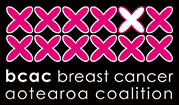A study comparing annual breast screening to screening personalised according to a woman’s risk was presented at the San Antonio Breast Cancer Symposium.
BCAC Secretary Fay Sowerby, who attended the presentation, says she was intrigued by this new trial, WISDOM. Annual screening is standard in the United States, whereas screening takes place every two years for women in NZ.
The trial results to date provide interesting insights for New Zealanders despite this difference, Fay says. “New Zealand may gain benefit from initiating a similar trial so that we may learn more about the challenges those at higher risk may face, and at the same time enable those at lowest risk to be screened less frequently.”
The researchers, led by Mandy Che, say that the goal of the US research, which is ongoing, is to determine if personalised screening is as safe as annual screening, is more accepted by women and enables prevention of advanced cancers. The study looks at customising screening schedules and methods to patients according to their risk based on genetic test results and other factors such as family history and breast density.
The trial was initiated in response to US Preventative Taskforce recommendations in 2019 that suggested screening every two years for women in the US over the age of 50, and allowing for earlier screening for those with higher risk. It was found that few physicians and their patients had responded, preferring to continue with annual screening. The WISDOM team initiated their trial to understand whether a more personalised approach to risk would be of benefit to women.
Fay says neither annual screening in the US nor screening every two years in New Zealand is necessarily producing the level of benefit that we would all like. New Zealand may learn from this trial what a more personalised approach to screening may add in terms of early detection and survival benefit.
Another interesting aspect of the trial is that women can enrol directly with the trial, and take responsibility and accountability for the initial risk assessment and their ongoing involvement with the trial. The trial team acknowledged when speaking with Fay that re-screening and follow-up with some participants remained a challenge, as it does today in NZ’s population-based screening programme.
The researchers say results at 5 years will enable them to demonstrate whether personalised screening improves healthcare value by reducing screen volumes and costs without jeopardising outcomes.
About the trial
The WISDOM trial involves healthy women aged 40-74, with no prior diagnosis of breast cancer or DCIS. There are two study arms: annual screening or personalised risk-based screening. Participants are either randomly assigned to one of these arms or they can choose for themselves (self-selection). Two thirds of the participants are in the random group; the rest are in the self-selecting groups.
The abstract presented to the Symposium reports that: As of July 2019, the WISDOM study is open to all eligible women in California, North Dakota, South Dakota, Minnesota, Iowa, Illinois, and New Jersey. To date, 30,392 eligible women have registered, and 21,392 women have consented to participate in the trial. The median age was 56 years. 85% of participants were Caucasian, 2% African-American, and 5% Asian. 6% self-reported Hispanic ethnicity. The study aims to have 100,000 trial participants.
Fay says: “I wouldn’t describe the trial as perfect but it does focus on individualising screening using a broad range of factors to assess risk. This includes previously established and recently validated genetic and clinical risk-based factors including mutations in 9 genes, BRCA 1/2, TP53, PTEN, STK11, CDH1, ATM, PALB2, and CHEK2) and 229 common genetic variants (SNPs), mammographic density and co-morbidities.” It also looks at age, family history, breast biopsy results and ethnicity.
Five-year risk level thresholds are then used to stratify for low-, moderate- and high- risk. This risk stratification directs the starting age, timing and frequency of screening for the trial participants in the personalised screening arm.
The two arms of the study
- Annual arm: People in the annual arm are assigned an annual screening schedule along with the opportunity to receive a Breast Health Specialist consultation if they are identified as at elevated risk by the Breast Cancer Surveillance Consortium (BCSC) model.
- The BCSC Risk Calculator is an interactive tool developed to estimate a woman's five-year risk of developing invasive breast cancer. In 2015, the BCSC risk calculator was updated to include benign breast disease diagnoses and to estimate both five-year and ten-year breast cancer risk.
- Personalised arm: those in the personal arm are assigned a screening schedule according to their risk assessment. Anyone who tests positive for a genetic mutation or is at elevated risk will receive a breast specialist consultation. Some women will have access to an active risk reduction tool (Breast Health Decisions Tool) that offers suggestions around risk reducing interventions.
Enhancing diversity
The researchers report that they are expanding the number of American states involved in the study to strengthen generalisability. Other states being included are Alabama and Louisiana. Future expansion regions include Texas, Florida, South Carolina, Oklahoma, Montana and New Mexico.
“With the engagement of patient advocates and community partnerships, expanding diversity recruitment will strengthen our scientific knowledge of breast cancer risk and increase access to personalized breast cancer screening recommendations for all women,” the researchers write.
WISDOM enrolment will continue through 2020 for US women.



